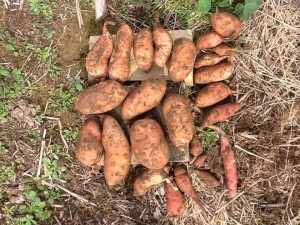 I love sweet potatoes. I mean LOVE them! Mashed, baked, as fries, pies, covered in horrible marshmallows…it doesn’t matter, I want them.
I love sweet potatoes. I mean LOVE them! Mashed, baked, as fries, pies, covered in horrible marshmallows…it doesn’t matter, I want them.
So when I decided to grow my own, I searched the internet for ideas and hints. I found nurseries that specialized in SP slips…you know those vines that come off a SP when you suspend it in a jar of water? They are expensive and shipping will kill you. So I made my own. I wanted ones that were not treated with anything, so on a trip into the city I found some organic SP. Once you have your SP, it’s simple:
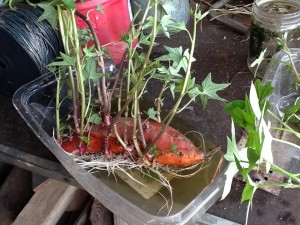
1–Cut your SP in half. In half lengthwise or widthwise doesn’t matter, you will just have to use different containers (read step two before you cut).
2–Stick some toothpicks in it so that the cut end will be submerged in a jar/container of water about half an inch. Make sure there is enough room around the rim of the jar for the SP to expand a bit…about 1/4 of an inch all the way around. You can also cut them in half lengthwise and place them in a shallow dish.
3–Wait for the vines to grow and maintain the water level. You can also add 1-2 tablespoons of compost to the jar for a nutrient boost.
4–Once the vines are at least 6 inches long, break them off as close to the SP as possible.
5–Place the vines in a shallow dish (a pie pan or plastic bakery container work well) and fill it with just enough water so the vines, not the leaves, are covered. You may have to add a weight like a rock or stick to hold them in the water. Make sure you space them out enough so that when it is time to remove them, the roots are not too tangled…approx. 4 inches apart.
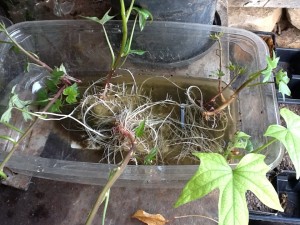
6–In a couple of days you should see roots start to form along the vine. Move to a pot and cover the roots with a little soil, maybe a tablespoon at a time. Keep doing this throughout the day until you have a mud consistency.
7–The next day, add a little more soil. Do not stir or disturb the roots.
8–The next day, add more soil. Add more water if it is too dry, but it should be like damp potting soil, not muddy.
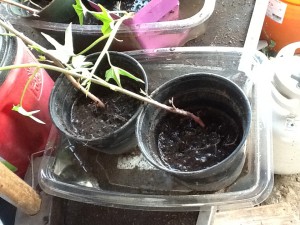
9–Leave the slips like this for at least 2 more days. This is how it becomes accustom to being in soil instead of water.
10–When you are ready to plant, remove the slip with as much soil as you can, and gently transplant. You can transplant into the ground once soil temp is 70º F. The looser the soil the better, but I grew my first crop in clay soil with some added compost. Like most root crops, the least resistance the better. Unlike regular potatoes, which SP are not related to, there is no need to hill up over the growing plant.
It is important to remember that the tubers grow under the main stem. Any vines that touch the ground will try to send down roots to turn into SP. If allowed to do this, the ones under the main plant won’t produce well and you will find lots of pencil sized SP along the vines. You can either occasionally go out and lift the vines, put down some heavy-duty weed block (maybe some cardboard sheets), or grow them on a trellis or in a pot. A trellis isn’t have to be fancy…2 pallets secured together on end to form a triangle and in a few weeks you won’t even see it. If you share your living space with deer, rabbit, sheep, or goats, make sure your plants are protected…they will tip-off new growth or take it down to the ground. If this should happen, curse and cry, but don’t pull up the plant! Side dress with about 1/4 cup compost 6 inches from the roots and water well. I did this with my plants the deer ate to almost nothing and they came back within a week.
The best way to remember how your SP will grow is by the A-F grading system. SP like it hot!!! So if it is 90-100 degrees, they are growing at a grade A. So then, B=80-90, C=70-80, D=60-70, and F=below 60. You don’t want them in the ground until the soil is above 70 degrees. They can tolerate drought better than most, but they still need at least inches of rain to produce a good tuber. One gallon of water a week equals an inch of rainfall. What I do is cut the bottom off a milk jug and turn it spout down and bury it about 2-3 inches into the ground and put a rock in it to keep it in place (earlier in the season you can use this for a mini greenhouse for your tomatoes, too). When it is time to water, I fill that up, give or take a bit, and know it has what it needs.
SP are harvested before the first frost here in Missouri. They take 100 to 140 days from planting to mature. If you are in the South, you may want to keep track of your planting and harvest date.
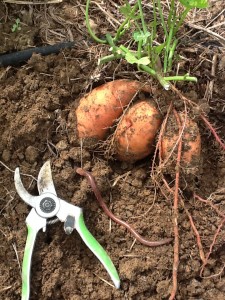
Tubers are easily harvested by digging them up with a fork. Start about a foot away from where the SP are growing to be safe. Loosen the soil and move closer until you lift them up. Gently pull them up and separate them from the plant. At this point you can easily bruise or scratch the skin off, so LIGHTLY brush off the dirt and place them in a shady place outside for a few hours. When they are ready to come inside, again, lightly brush off the dirt and place them in a cool dark place for about 3 months. You want good air circulation around them so a single layer in a basket or wire rack works well. In this curing process, your SP are loosing moisture and condensing the sugars. Unlike most fruits and veg, a fresh picked SP is not what you what to eat. It must cure to become sweet. Three months is a long time to wait. But when you finally eat one, and realized what a sweet potato should taste like, you will fall in love. And then you will kick yourself for not growing more!
